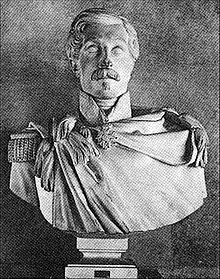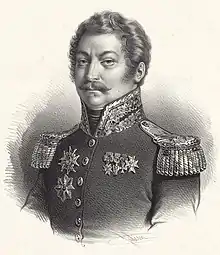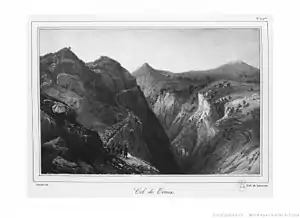Alexandre Charles Perrégaux
Alexandre Charles Perrégaux (born in Neuchâtel on 21 October 1791 and died in the Mediterranean Sea on 6 November 1837) was a French officer who participated to the French conquest of Algeria.[2]
Alexandre Charles Perrégaux | |
|---|---|
 | |
| Birth name | Alexandre Charles Perrégaux |
| Born | 21 October 1791 Neuchâtel, |
| Died | 6 November 1837 Mediterranean Sea |
| Buried | |
| Allegiance | France |
| Branch | French Army |
| Years of service | 1817-1837 |
| Rank | Maréchal de camp |
| Battles/wars | French conquest of Algeria
|
| Awards | |
| Spouse(s) | Cécile de Pourtalès (death 1830)[1] |
Family
Alexandre Charles Perrégaux is the second son of the named "Charles Albert Henri Perregaux" (1757-1831) who was state councilor and more tazrd colonel inspector of militias and knight of the red eagle.[3]
He had married in Neuchâtel on 5 December 1825 the named Cécile de Pourtalès, born on 9 September 1904 and died in Paris on 24 March 1830.[4]
Caught in the military sights of expeditions to North Africa, He left no children or posterity.
Injury
Alexandre Charles Perrégaux was on 12 October 1837 in the encirclement and siege of Constantine with General Charles-Marie Denys de Damrémont (born 1783) when the latter was killed by a cannonball.[5]
Seeing Damrémont, the general-in-chief of the expedition, fall dead, Perrégaux rushed towards him to rescue him and take his body away, and while bending down on his body he received a bullet which hit him and which went through his nose and sank deep enough into the palate of her mouth.[6]
He fell unconscious and wounded on the dead body of the one who had been his leader and his friend for years at the start of the colonial conquest of Algeria.[7]
Perregaux was rushed back by his soldiers to the town of Annaba, and he was embarked on a boat to take him through the Mediterranean Sea to France in an attempt to save and heal him there.[8]
Death
General Perrégaux was unable to reach France by sea in order to extract the bullet that wounded her, by means of a surgical operation and thus save her life.[1]
He succumbed to his wounds and thus died during the Mediterranean crossing before his arrival in France.[9]
The boat carrying him docked in a port on the island of Sardinia, and he was buried in a cemetery in the city of Cagliari.[10]
Gallery


 First Battle of Boudouaou (1837)
First Battle of Boudouaou (1837) Siege of Constantine (1837)
Siege of Constantine (1837)
See also
- French conquest of Algeria
- Expedition of the Col des Beni Aïcha (1837)
- First Battle of Boudouaou (1837)
- Siege of Constantine (1837)
Bibliography
- Valentin Devoisins (1838). Recueil de documents sur l'expédition et la prise de Constantine. Paris: Joseph Corréard, Éditeur. pp. 25–29.
- Frédéric Alexandre Marie Jeanneret (1863). Biographie neuchâteloise, Volume 2. Le Locle: Eugène Courvoisier, Libraire-Éditeur. pp. 186–193.
- Société historique algérienne (1871). Revue africaine. Volume 15. Algiers: Bastide, Libraire-Éditeur. pp. 5–13.
- Narcisse Faucon (1890). Le livre d'or de l'Algérie: histoire politique, militaire, administrative. Paris: Augustin Challamel, Éditeur. p. 449.
- Jules de Cuverville (1899). Armée, marine, colonies, Volume 1. Paris: Éditions des Armées de Terre et de Mer. pp. 193–195.
References
- "Bulletin de la Société héraldique etʹgenéalogique de France - Société héraldique et généalogique de France, Paris - Google Livres". Books.google.dz. Retrieved 4 February 2021.
- "Le livre d'or de l'Algérie: histoire politique, militaire, administrative ... - Narcisse Faucon - Google Livres". Books.google.dz. Retrieved 4 February 2021.
- "Archivum heraldicum - Google Livres". Books.google.dz. Retrieved 4 February 2021.
- "Archivum heraldicum - Google Livres". Books.google.dz. Retrieved 4 February 2021.
- "Biographie neuchâteloise - Frédéric Alexandre Marie Jeanneret - Google Livres". Books.google.dz. Retrieved 4 February 2021.
- "Revue africaine - Google Livres". Books.google.dz. Retrieved 4 February 2021.
- "Expéditions de Constantine: accompagnées de réflexions sur nos possessions d ... - V. Devoisins - Google Livres". Books.google.dz. Retrieved 4 February 2021.
- "Recueil de documents sur l'expédition et la prise de Constantine - Valentin Devoisins - Google Livres". Books.google.dz. Retrieved 4 February 2021.
- "Biographie neuchâteloise - Frédéric Alexandre Marie Jeanneret - Google Livres". Books.google.dz. Retrieved 4 February 2021.
- "Armée, marine, colonies - Google Livres". Books.google.dz. Retrieved 4 February 2021.